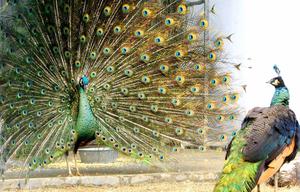 Two green peafowls live in a zoo in Suzhou, Jiangsu province. (WANG JIANZHONG / FOR CHINA DAILY)
Two green peafowls live in a zoo in Suzhou, Jiangsu province. (WANG JIANZHONG / FOR CHINA DAILY)
KUNMING-Yang Xiaojun was excited to learn the six green peafowls his team had raised since the end of last year had laid more than 20 eggs, offering new hope for the survival of one of the world's most threatened pheasants.
"These newly laid eggs bring hope to a rare species that has a wild population of less than 500 in China," Yang said of the progress in the captive breeding project.
In recent years, local authorities, along with scientific institutions and public welfare organizations, have beefed up efforts to revive the endangered species
The 58-year-old researcher with the Chinese Academy of Sciences' Kunming Institute of Zoology in Yunnan province has been leading a team trying to ensure more captive green peafowls "can soon return to the wild".
Native to the tropical and subtropical forests of Southeast Asia and southern China, the green peafowl is under national-level protection in China and listed on the International Union for Conservation of Nature Red List of Threatened Species.
From peacock brocade and ancient murals to imperial fans made of peacock feathers, the green peafowl is a key feature of traditional Chinese culture. In the Qing Dynasty (1644-1911), only high-ranking officials were permitted to wear hats with a green peafowl feather.
"Historically, green peafowls were widespread in provinces and regions including Hunan, Hubei, Guangdong and Guangxi, but it has been only spotted in southwestern China's Yunnan province since the 1990s, when the species had an estimated population of 800 to 1,100," Yang said.
"In the wild, green peafowls breed once a year, laying three to five eggs at a time. The animal is timid and will abandon its nest and run away at the slightest trouble. The chance of hatching a healthy green peafowl is very low."
ALSO READ: CRare deer-like species photographed for first time in wild
Reviving the species
In recent years, local authorities, along with scientific institutions and public welfare organizations, have beefed up efforts to revive the endangered species.
As of last year, Yunnan had invested more than 11 million yuan (US$1.56 million) in the protection of green peafowls, implementing monitoring systems and providing water and food sources for the birds.
Scientific institutions are also working on the species' populations and habitats.
A survey conducted over several years by Chinese scientists showed that in 2018 there was a dramatic nationwide population decline in the green peafowl. The bird had disappeared from 60 percent of its distribution areas in China, and remained in only 22 counties in Yunnan.
Green peafowl populations and large habitats have been found in the middle and upper reaches of the Yuanjiang River in Yunnan. The extremely high survival rate of nestlings in some nature reserves has laid a solid foundation for the restoration of the species' population, Yang said.
On March 20, in the first case of public interest litigation regarding Yunnan's green peafowls, a court ruled the construction of a hydropower station be suspended because of the damage the project would likely inflict on the bird's habitats.
READ MORE: Draft rules to protect wildlife in Heilongjiang
Globally, the green peafowl is struggling to survive. According to the IUCN, there are only 15,000 to 30,000 green peafowls worldwide.
"China's efforts in saving the species may also carry great significance for the whole world," Yang said.


